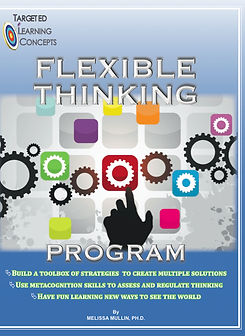
Flexible Thinking is Fun!
Why build flexible thinking skills?
Thinking creatively, seeing things from a different perspective and quickly adapting to changes helps us solve everyday problems.
Nicole's Story
“I can’t do it! It’s wrong! ” Nicole announces loudly. Soon Nicole will be in tears and declaring that the book is wrong and that this is not the way the teacher showed the class how to do the problem.

Nicole has difficulty with set-shifting, which leads to her struggle with homework.
Set-shifting is a component of cognitive flexibility that impacts a student’s ability to shift attention.
There are multiple types of set shifting, but they all require the ability to let go of one idea to consider another.
The ability to abandon an old strategy and adapt to a new rule is a key life skill. Children with set-shifting difficulty have trouble being flexible.
It is challenging for these children to deal with change, be it routines, rules or integrating new information. When a child with set-shifting issues makes a mistake, it is hard for her to find it, correct it, and move on.
Set-shifting and flexible thinking are important components of cognitive flexibility, an essential executive functioning skill.
How to build Flexibility Skills
-
Games are some of the best ways to build flexible thinking skills. Coaching is required while playing these games to help your child develop new thinking strategies.
The Flexible Thinking Program provides fun games and guided instructions on how to help your child to become more a more flexible thinker.

Tips for teaching Cognitve Flexibility
-
Start with teaching inhibition skills.
-
Teach Metacognition Skills
-
Play Flexible Thinking games and activities
-
Teach Emotional Regulation
The Flexible Thinking Program
The Flexible Thinking Program includes activities that build flexible thinking skills.
The activities are separated into five sections:
-
CROSSING THE MIDLINE
-
CHANGING THE RULES
-
ORGANIZING YOUR THOUGHTS
-
DIFFERENT WAYS TO THE SAME ANSWER
-
STOP-A-BILITY
Each section taps a different aspects of flexible thinking. Practiced, in conjunction, they comprise a well-balanced plan to build flexible thinking skills.
Crossing the Midline Activities
Impacts Reading (left-to-right fluency), Handwriting (fine motor), Body Movements (gross motor).
CROSSING THE MIDLINE activities encourage students to use both sides of his/her brain together. They generally involve physically crossing over the “midline,” an invisible line down the center of the body that separates the body into “left side” and “right side.” Crosses can happen with hands, arms, feet, and legs (e.g. “put your right hand on your left shoulder”). Practice in this area helps build the ability to coordinate one side of the brain with the other.
Changing the Rules Activities
Impacts Reading and Math skills.
CHANGING THE RULES activities are classic examples of set shifting. The student is asked to do a task then they must shift to doing it a new or different way.Successful learners are able to quickly and seamlessly shift their thoughts in novel ways.
Organizing your Thoughts Activities
Impacts Writing and Math skills
ORGANIZING YOUR THOUGHTS activities encourage students to stop, think, and organize their thoughts before they execute their plan. For example, they may want to “zoom out” and think about the big picture before they start going into details.
.
Different Routes to the Same Answers Activities
Impacts Math, Reading, Problem-Solving, and Social Skills.
DIFFERENT ROUTES TO THE SAME ANSWERS activities help students see that for many problems, there is not just one way to look at it or do it. These activities help the student open up to the possibility of taking different approaches to problem-solving.
Stop-ability Activities
Impacts classroom transitions, homework, Math, and Social Skills.
STOP-ABILITY activities assist the student in the quick shifting of topics. Students will have to quickly “shift” their cognitive thinking in response to changes in the game.



